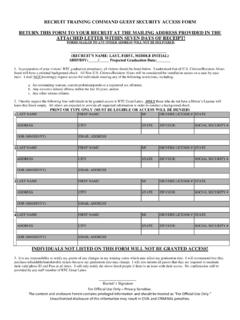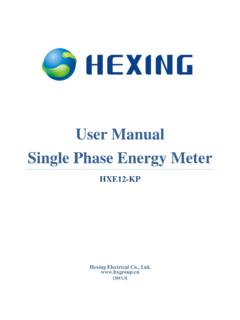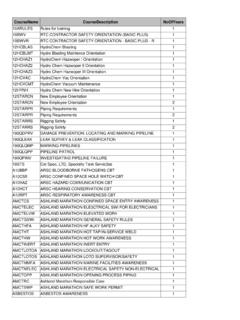Transcription of USEPA REGION 2
1 DuPont Pompton Lakes Works 2000 Cannonball Road Pompton Lakes, NJ 07442 July 3, 2014 Mr. Perry Katz USEPA REGION 2 290 Broadway Mail Code: 22nd Floor New York, NY 10007-1866 RE: Response to USEPA /NJDEP Comments on the Ramapo River and Pompton River Substrate Characterization Technical Memorandum DuPont Pompton Lakes Works Pompton Lakes, New Jersey Dear Mr. Katz: Please find responses below to the Environmental Protection Agency ( USEPA ) and New Jersey Department of Environmental Protection (NJDEP) comments on the Ramapo River and Pompton River Substrate Characterization Technical Memorandum (Technical Memorandum) submitted on February 26, 2014 (URS, 2014). DuPont received comments from USEPA /NJDEP on the Technical Memorandum in an email dated June 20, 2014. The text of the USEPA /NJDEP comments is provided followed by the response in bold font.
2 OBJECTIVES AND SPATIAL SCOPE Page 2, paragraph 2 The area between Hamburg Turnpike and Pompton Lake Dam that was not subject to substrate mapping due to restricted access and safety concerns should be depicted on a Figure (a figure akin to Figure 9). Access to areas previously restricted during the August 2013 substrate mapping survey will be revisited prior to 2014 field sampling operations. If access can be gained to previously inaccessible areas, those areas will be surveyed for the presence of fine-grained sediment deposits and representative samples of fine-grained sediments will be collected consistent with current protocols to characterize mercury concentrations. Areas that are not accessible due to restricted access and/or safety concerns ( , the area between Hamburg Turnpike and Pompton Lake Dam) will be depicted as Unmapped in the subsequent technical memorandum that will be prepared to summarize the findings of the sediment characterization sampling.
3 Mr. Katz July 3, 2014 Page 2 MAPPING SURVEY FINDINGS Page 4, paragraph 3 Clarify which survey location is referenced in the last sentence of the paragraph. The survey location referenced in the last sentence of paragraph 3 on page 4 is the only survey location identified within the Unmapped area on Figure 5 in the Technical Memorandum. The substrate at this specific location was classified as coarse sand/granule (Type 3); however, this classification could not be applied to the surrounding area due to inaccessibility by boat. PREVIOUS CHARACTERIZATIONS Page 5, Paragraph 1 -- Indicate who the prior physical characterization of sediments was performed on behalf of, if known. The prior physical characterization of sediments referenced in the Technical Memorandum was conducted as part of a 2012 feasibility study for the removal of the Pompton Dam and Pequannock Dam.
4 The feasibility study was performed on behalf of the State of New Jersey Division of Property Management and Construction (DPMC) by Civil Dynamics, Inc. (Civil Dynamics, 2012). GENERAL COMMENTS 1. There needs to be reference to the Health & Safety Plan to be utilized during the field operations. Field sampling operations proposed in the Technical Memorandum will be conducted consistent with the health and safety procedures outlined in DuPont PLW HASP Addendum #4 Pompton Lake Sediment Sampling dated July 26, 2013 (HASP) (OBG, 2013). Prior to mobilization into the field, a project safety analysis (PSA) will be conducted to review safety procedures outlined in the HASP for the specific sampling tasks. The PSA for sediment sampling procedures will include a review of the findings of the PSA conducted for the substrate mapping survey on August 6, 2013 with key learnings from the August 2013 substrate mapping survey incorporated into the PSA prepared for the 2014 sampling effort.
5 In addition, daily safety tailgate meetings will be held at the start of each sampling day to review the scope of work and associated hazards. 2. There needs to be reference to the Quality Assurance/Quality Control Procedures to be utilized during the field operations. Sampling and analysis procedures will be consistent with the procedures outlined in the Quality Assurance Project Plan (QAPP) Worksheets prepared for the 2013 sediment sampling effort in Pompton Lake, as submitted to USEPA in a letter dated August 28, Mr. Katz July 3, 2014 Page 3 2013 (DuPont CRG, 2013). Analytical methods specific to the scope of work outlined in the Technical Memorandum will be performed using USEPA - or ASTM-approved methods with the method detection limits (MDLs) and practical quantitation limits (PQLs) presented in Table 1 (attached).
6 In addition to field samples, quality assurance/quality control (QA/QC) samples for sediment will include equipment blanks, field duplicates, and matrix spike/matrix spike duplicates samples (MS/MSD) collected at the frequency specified in the QAPP Worksheets (DuPont CRG, 2013). 3. The New Jersey certified lab needs to be identified that is performing the sediment sampling analyses. Analyses of sediment samples will be performed by Eurofins Lancaster Laboratories, Inc. (Lancaster Laboratories), a New Jersey-certified laboratory (Laboratory Certification ID #PA011). 4. What efforts will there be to identify other potential sources of mercury within the study area? Floodplain features ( , drainages, tributaries, outfalls) that may indicate other potential sources of mercury to the Ramapo River and Pompton River downstream of the Pompton Lake Dam were noted during the 2013 substrate mapping survey and previous field reconnaissance efforts.
7 Additional observations of these features and other features not previously noted will be documented during the field sampling effort. In addition, desktop reviews of potential mercury sources within the watershed may also be conducted. 5. A proposed schedule to perform the work needs to be provided. The schedule for the proposed work includes the following milestones for 2014: Field mobilization and sampling Tentatively scheduled for the week of July 21st, dependent on weather and river conditions; Receipt/validation of analytical data 60 days following the submittal of sediment samples for analysis; and Submittal of a technical memorandum to USEPA /NJDEP summarizing the findings of the sediment characterization sampling 45 days following the receipt/validation of analytical data.
8 Mr. Katz July 3, 2014 Page 4 6. If at all possible, sediment samples should be collected immediately above dams in the waterway. These are high deposition areas and may hold relatively high mercury levels. DuPont has excluded these areas from sampling, citing safety concerns. If areas immediately upstream of the Pompton Dam and Pequannock Dam can be accessed safely, sediment will be sampled from up to two additional stations upstream of each dam (a maximum of four additional sample stations). Prior to field mobilization, an assessment of the current conditions upstream of the dams will be completed to evaluate if sampling can be conducted safely and to develop a safe sampling approach. Specific conditions that will be evaluated include, but are not limited to: Flow conditions, specifically the volume of water spilling over the dams at the time of sampling; Ability to anchor the boat upstream of the dams; and Potential to establish a safety line across the river a safe distance upstream of the dams.
9 If it is determined that the areas can be safely accessed, a specific plan will be developed prior to mobilization to address the potential hazards associated with work adjacent to low-head dams. This plan will be carefully reviewed with site health and safety personnel and the project team during the PSA that will be conducted prior to the implementation of the field program. 7. The sampling proposal calls for sediment cores to be collected and analyzed. These represent a vertical composite which may obscure relatively thin layers of higher mercury deposition ( , post-Irene or Hurricane Sandy sediment transport out of Pompton Lake and subsequent downstream deposition). DuPont should try to identify discrete depositional layers that may represent mercury reservoirs to the ecosystem.
10 It is unclear the evidence which would support the supposition that thin layers of mercury deposition would exist in this portion of the river specifically related to sediment in Pompton Lake given the uncertainty associated with the mixing of suspended sediment loads from upstream areas of the Ramapo River watershed with sediment potentially suspended and transported from Pompton Lake during storm events. The purpose of this sampling program as presented and discussed during combined technical meetings is to determine mercury concentrations in sediment at locations downstream of the Pompton Dam. The need for additional investigation would be predicated on the results of this program. In order to ensure consistency with previous investigations sediment samples will be collected using the procedures agreed upon with the regulatory agencies for the 2013 sediment sampling completed in Pompton Lake.

















